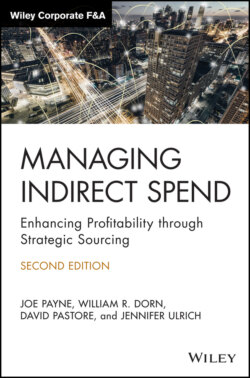Читать книгу Managing Indirect Spend - Joseph Payne, Joe Payne - Страница 27
WHAT IS DATA COLLECTION?
ОглавлениеThe Data Collection phase is where you generate the insights that will drive you throughout the rest of your initiative. Those insights will inform your strategy and ensure that the products and services you source will align with your organization's requirements. Having a detailed understanding of your current state in terms of price, quality, and service provides the context for analyzing offers from alternate suppliers in a much more meaningful way. In addition, establishing an accurate starting point helps justify your position when you need to ensure alignment or justify your decision‐making.
By collecting and developing a thorough understanding of the data, you have a foundation to conduct a gap analysis and to explore new or changing requirements. Providing alternate suppliers with a complete and accurate picture of your requirements eliminates any guesswork they may need to incorporate in their proposals and eliminates additional costs that may arise due to ambiguity. Before digging into the most effective ways to collect data, let's first identify the types of data you need to get started on an initiative.
On the surface, quantity and price may look like simple data points. However, once you begin to dig, you will discover that some tricky complexity can be hidden within these data points. For example, a logical first set of questions is, “How much does the company buy (total units) and how much does it cost (price per unit)?” As you explore the answer, the notion of price quickly grows in complexity when you realize that unit cost is not the only component you need to consider. A number of other factors come into play: Are there quantity price breaks? Is freight included, or are there additional charges? What are the payment terms, and is there a discount for early payment?
In many cases, net cost per unit is not the only way (nor the most advisable way) to evaluate price. Consider, for example, an initiative that includes a basket of items, some purchased regularly and others rather infrequently, such as office supplies. In this scenario, high‐volume items might be identified as having a fixed unit price, but what about items for which a fixed price wasn't negotiated? This is a fairly common occurrence because it is not likely that you will have negotiated a fixed unit price for everything in a supplier's catalog. Still, controlling the costs of the less‐frequent purchases is also important. For these items, you likely have a discount structure based on a list price. For instance, pens and pencils that are not listed as contract items might receive a 20% discount off of the list price. In this example, price is a combination of net costs, list prices, and discounts. Collecting pricing information may appear to be a simple concept, but as you can see, many factors must be considered to understand the total cost.
Usage or volume (how much you buy of a particular product or service) is the other basic component of the Data Collection phase. In most cases, companies consider the last 12 months of usage to be reflective of future purchases. However, this may not always be the case. If business has decreased or increased, processes have changed, or requirements are being met through alternate means, volume will likely have shifted, and those changes must be documented before engaging in the RFx phase. In some cases, consolidating volumes across locations (if you have multiple sites buying the same products) might make sense. In other cases, the data should stay separate. Order size may also make a big difference, so line‐item detail for purchases across locations becomes critical. As we discuss later in this chapter, getting this level of detail out of your own internal systems can be a challenge—sometimes it is impossible.
Price and usage are the foundation of a spend analysis, but many other factors should also be considered while you're collecting and analyzing data. Understanding existing contractual commitments, contract terms and conditions, quality levels, and scope of work are also important. Business concerns such as the order‐to‐payment process, the shipping and receiving process, and a detailed understanding of the historical relationships with current suppliers should all be reviewed and evaluated during this stage. With all this data to collect, getting started can prove a daunting task. In reality, it is not that difficult, as long as you have a clear idea of what you are looking to accomplish and an organized plan to get you there.
